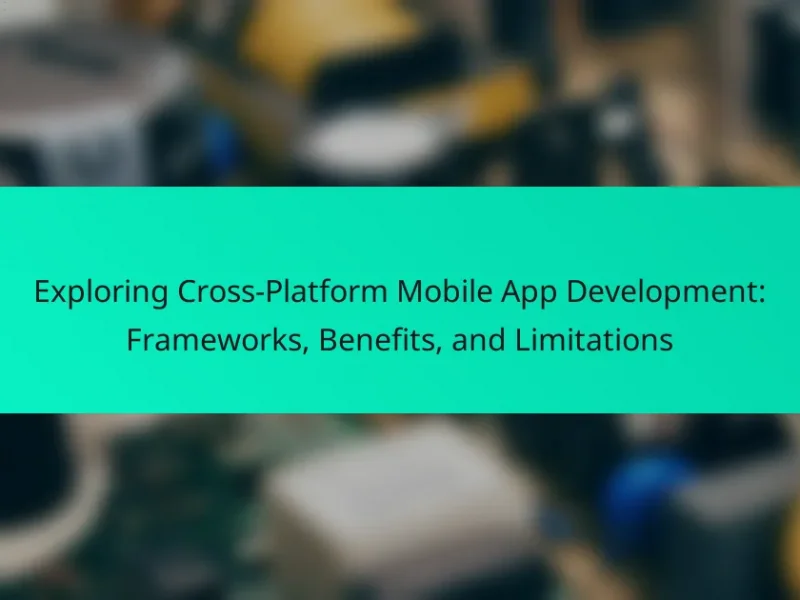Choosing the right mobile app development platform is crucial for the success of your app project. Key factors to consider include project requirements, target audience, device compatibility, and platform features such as user interface capabilities and integration options. Additionally, evaluating development costs, scalability for future growth, and available community support is essential. Common pitfalls include overlooking scalability, ignoring integration capabilities, and neglecting user experience. Best practices for evaluation involve assessing features, pricing, scalability, and customer support, along with reviewing user testimonials and case studies to make an informed decision.

How do you determine the right mobile app development platform for your needs?
To determine the right mobile app development platform, assess your project requirements first. Identify the target audience and devices you want to support. Evaluate the platform’s features, such as user interface capabilities and integration options. Consider the development cost and time for each platform. Analyze the scalability options available for future growth. Research community support and resources for troubleshooting. Review case studies or testimonials from businesses with similar needs. Select a platform that aligns best with your specific project goals and budget constraints.
What key features should you consider when selecting a mobile app development platform?
When selecting a mobile app development platform, consider scalability, ease of use, and integration capabilities. Scalability ensures the platform can support app growth and increased user demand. Ease of use affects the development speed and efficiency. Integration capabilities allow seamless connection with third-party services and APIs. Additionally, assess the platform’s support for multiple operating systems. This ensures your app can reach a wider audience. Security features are also critical to protect user data. Finally, evaluate the cost structure to ensure it aligns with your budget and project scope.
How do user interface and user experience impact your choice?
User interface (UI) and user experience (UX) significantly impact your choice of mobile app development platform. A well-designed UI enhances usability and makes navigation intuitive. This leads to higher user satisfaction and retention rates. Conversely, a poor UI can frustrate users, causing them to abandon the app. UX encompasses the overall experience a user has with the app. Positive UX fosters trust and encourages continued use. Research shows that 88% of online consumers are less likely to return to a site after a bad experience. Therefore, selecting a platform that prioritizes UI and UX is crucial for success.
What programming languages and frameworks are essential for your app?
Essential programming languages for app development include Java, Swift, and JavaScript. Java is widely used for Android apps. Swift is the primary language for iOS development. JavaScript enables cross-platform development through frameworks like React Native. Frameworks such as Flutter and Xamarin also facilitate mobile app creation. Each language and framework has specific advantages. Java has a large community and extensive libraries. Swift offers performance and safety features for iOS. JavaScript allows for rapid development and flexibility. Flutter provides a single codebase for both iOS and Android. Xamarin integrates well with Microsoft tools. These languages and frameworks are critical for effective mobile app development.
Why is pricing an important factor in choosing a mobile app development platform?
Pricing is an important factor in choosing a mobile app development platform because it directly impacts the overall budget and return on investment. Different platforms offer varying pricing models, including one-time fees, subscription plans, and pay-as-you-go options. Understanding these models helps businesses align their financial resources with their app development goals. For instance, a platform with lower upfront costs may lead to higher long-term expenses due to hidden fees or limited features. Additionally, pricing can indicate the quality of support and resources available. A platform that is too cheap may lack essential tools or customer service, which can hinder app development. According to a survey by Clutch, 44% of businesses consider budget constraints as a critical factor in their platform selection process. Thus, pricing not only affects immediate costs but also influences strategic decisions in app development.
What are the different pricing models available for mobile app development platforms?
Mobile app development platforms typically offer several pricing models. Common models include subscription-based pricing, where users pay a recurring fee for access. One-time payment models involve a single upfront cost for the software. Freemium models provide basic features for free, charging for advanced functionalities. Pay-as-you-go pricing charges based on usage metrics like API calls or storage. Additionally, custom pricing may be available for enterprise solutions tailored to specific needs. Each model caters to different business requirements and budgets.
How can you estimate the total cost of ownership for a platform?
To estimate the total cost of ownership for a platform, identify all associated costs over its lifecycle. This includes initial acquisition costs, ongoing operational expenses, and potential upgrade costs. Consider direct costs like licensing fees and hardware expenses. Also, factor in indirect costs such as training, maintenance, and support. Analyze the expected lifespan of the platform to project long-term expenses. Use historical data or case studies to benchmark costs against similar platforms. This comprehensive approach ensures an accurate estimation of total ownership costs.
How does scalability influence your choice of mobile app development platform?
Scalability significantly influences the choice of mobile app development platform. A scalable platform can accommodate growing user demands and increased data processing without performance degradation. For example, platforms like AWS and Google Cloud offer robust scalability features. They enable developers to easily adjust resources based on app usage. This flexibility is crucial for businesses anticipating growth. Choosing a non-scalable platform can lead to limitations and increased costs over time. Therefore, assessing scalability is essential for long-term app success and user satisfaction.
What scalability features should you look for in a platform?
Look for features like automatic scaling, load balancing, and multi-tenancy in a platform. Automatic scaling adjusts resources based on demand. Load balancing distributes incoming traffic across multiple servers. Multi-tenancy allows multiple users to share the same application instance while keeping their data separate. These features ensure that the platform can handle increased traffic and user activity efficiently. According to a study by Gartner, platforms with these scalability features can reduce downtime by up to 30%.
How can you assess a platform’s ability to handle growth and increased demand?
Evaluate a platform’s scalability features to assess its ability to handle growth and increased demand. Check if the platform supports horizontal and vertical scaling. Horizontal scaling allows adding more machines, while vertical scaling increases resources on existing machines. Analyze performance metrics under load conditions. Conduct stress testing to identify how the platform performs with increased user activity. Review the platform’s architecture, focusing on microservices and cloud-native capabilities. Platforms designed for cloud environments typically handle demand spikes better. Investigate customer testimonials and case studies for real-world performance insights. Research industry benchmarks to compare scalability across platforms.

What are the common pitfalls to avoid when choosing a mobile app development platform?
Common pitfalls to avoid when choosing a mobile app development platform include overlooking scalability. Selecting a platform that cannot grow with your user base can lead to performance issues. Ignoring integration capabilities is another mistake. A platform should easily connect with existing systems and third-party services. Failing to assess development costs upfront can result in budget overruns. It’s important to understand both initial and ongoing expenses. Neglecting user experience can also be detrimental. A platform should support intuitive design and smooth navigation. Lastly, not considering community support can hinder troubleshooting. A strong developer community can provide valuable resources and assistance.
How can vendor lock-in affect your long-term strategy?
Vendor lock-in can significantly limit your long-term strategy. It restricts flexibility in choosing alternative solutions. Organizations may face increased costs if they want to switch vendors. This situation often leads to dependency on a single vendor’s technology. According to a 2020 report by Gartner, 70% of companies experience challenges when attempting to migrate away from a vendor. Vendor lock-in can hinder innovation by constraining access to new technologies. It may also affect scalability, as companies might struggle to integrate new tools. Overall, vendor lock-in can undermine strategic growth and adaptability.
What are the signs of a platform that may lead to vendor lock-in?
Signs of a platform that may lead to vendor lock-in include limited interoperability with other systems. Such platforms often use proprietary technologies that hinder integration. Another sign is a lack of data portability, making it difficult to transfer data to other platforms. High switching costs also indicate potential lock-in, as migrating to a new platform may require significant resources. Additionally, platforms that offer unique features without alternatives can create dependency. Long-term contracts or commitments can further entrench users with a specific vendor. Lastly, insufficient support for open standards can limit flexibility and options for users. These signs collectively suggest that a platform may lead to vendor lock-in, impacting long-term business agility.
How can you mitigate the risks associated with vendor lock-in?
To mitigate the risks associated with vendor lock-in, organizations should adopt a multi-vendor strategy. This approach involves utilizing multiple service providers for different components of the application. It reduces dependency on a single vendor and enhances flexibility. Additionally, organizations should prioritize platforms that support open standards and interoperability. This ensures easier data migration and integration with other systems. Regularly reviewing contracts and service agreements is also crucial. This practice helps identify exit strategies and avoid unfavorable terms. Lastly, investing in training and documentation can empower teams to manage transitions effectively. These steps collectively enhance resilience against vendor lock-in.
What role does community support play in the success of a mobile app development platform?
Community support is crucial for the success of a mobile app development platform. It fosters collaboration among developers, leading to shared knowledge and resources. A strong community can provide quick solutions to technical issues. According to a survey by Stack Overflow, 90% of developers find community support essential for problem-solving. Platforms with active communities often see higher user retention rates. This engagement can drive innovation and improvements in the platform. Additionally, community feedback helps developers understand user needs better. Ultimately, robust community support enhances the overall user experience and platform credibility.
How can a strong community contribute to better problem-solving?
A strong community enhances problem-solving by facilitating collaboration and knowledge sharing. Members can pool diverse perspectives and expertise. This collective intelligence leads to innovative solutions. Research shows that groups with strong social ties solve problems more effectively. For example, a study by the National Institute of Health found that collaborative teams outperform individuals in complex problem-solving tasks. Strong community support also encourages risk-taking and experimentation, which are essential for finding creative solutions. Thus, a robust community significantly improves the problem-solving process.
What resources should you look for in a platform’s community support?
In a platform’s community support, you should look for documentation, forums, and tutorials. Documentation provides essential guides and API references. Forums allow users to ask questions and share solutions. Tutorials offer step-by-step instructions for using the platform effectively. Additionally, check for user groups on social media for real-time support. Support channels like chat or email are also valuable for direct assistance. These resources enhance user experience and facilitate problem-solving.

What are the best practices for evaluating mobile app development platforms?
The best practices for evaluating mobile app development platforms include assessing features, pricing, scalability, and support. Start by identifying the specific features required for your app. Look for platforms that offer a robust set of tools for development, testing, and deployment. Next, analyze the pricing structure. Ensure it aligns with your budget and offers value for the features provided. Scalability is crucial for future growth. Choose a platform that can accommodate increased user demand and additional features over time. Evaluate customer support options. Reliable support can significantly impact your development process. Lastly, consider user reviews and case studies. They provide insight into the platform’s performance and reliability. These practices ensure a comprehensive evaluation of mobile app development platforms.
How can you conduct effective research on potential platforms?
To conduct effective research on potential platforms, start by defining your project requirements. Identify key features necessary for your mobile app. Evaluate various platforms based on these criteria. Compare pricing models to understand cost implications. Analyze scalability options to ensure future growth. Review user feedback and expert opinions for insights. Utilize comparison tools and resources for data aggregation. Check case studies of similar projects to gauge platform performance. This structured approach will lead to informed decisions.
What criteria should you use to compare different platforms?
When comparing different platforms, consider features, pricing, scalability, and user experience. Features include the tools and functionalities offered by each platform. Pricing should encompass initial costs, subscription fees, and potential hidden charges. Scalability refers to the platform’s ability to grow with your app’s needs. User experience involves the ease of use for both developers and end-users. Evaluating these criteria ensures that you select a platform that aligns with your project requirements and budget.
How important are user reviews and case studies in your evaluation?
User reviews and case studies are crucial in the evaluation process. They provide real-world insights into the performance and usability of mobile app development platforms. User reviews reflect the experiences of actual customers, highlighting strengths and weaknesses. Case studies illustrate successful applications of the platform in specific contexts. According to a 2021 survey by BrightLocal, 87% of consumers read online reviews for local businesses. This statistic underscores the influence of user feedback on decision-making. Additionally, case studies can demonstrate measurable outcomes, such as increased user engagement or revenue growth. Therefore, both user reviews and case studies significantly inform evaluations.
What tips can help you make a well-informed decision?
Research the available platforms thoroughly. Compare features, pricing, and scalability options. Analyze user reviews and case studies for insights. Evaluate the technical support and community resources offered. Consider the platform’s integration capabilities with existing systems. Assess the long-term viability and updates of the platform. Test the platform through demos or trial versions before committing. Seek expert opinions or consult industry professionals for additional guidance.
How can prototyping and testing influence your platform choice?
Prototyping and testing can significantly influence your platform choice by providing insights into usability and functionality. Early prototypes allow for user feedback, highlighting necessary adjustments. This feedback can guide the selection of a platform that best meets user needs. Testing different platforms with prototypes reveals performance issues or limitations. It ensures that the chosen platform can support the desired features effectively. Additionally, successful testing can validate the feasibility of the app’s design on a specific platform. This process reduces the risk of costly changes later in development. Ultimately, informed decisions based on prototyping and testing lead to a more effective platform choice.
What common mistakes should you avoid during the selection process?
Common mistakes to avoid during the selection process include failing to define project requirements clearly. This can lead to choosing a platform that does not meet needs. Another mistake is neglecting to evaluate scalability options. Platforms that cannot grow with your app can hinder future development. Additionally, overlooking pricing structures can result in unexpected costs. It’s crucial to understand both upfront and ongoing expenses. Ignoring user support and community resources is also a mistake. Strong support can significantly impact development efficiency. Lastly, not testing the platform with a prototype can lead to compatibility issues. Testing helps identify potential problems early in the process.
The main entity of the article is the mobile app development platform. The article provides a comprehensive guide on selecting the right platform by evaluating key features, pricing models, and scalability options. It emphasizes the importance of user interface and experience, programming languages, and community support in the decision-making process. Additionally, it highlights common pitfalls to avoid, strategies to mitigate vendor lock-in, and best practices for effective research and evaluation. The content is structured to assist businesses in aligning their project requirements with the most suitable mobile app development platform.


